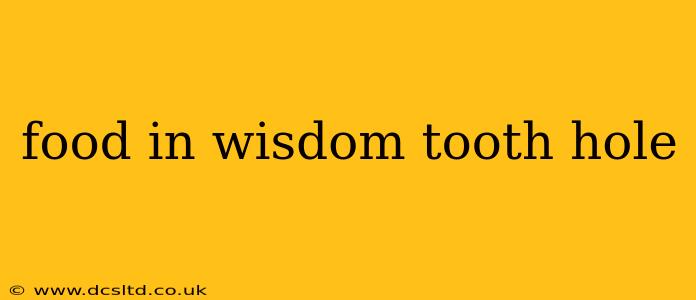Getting a wisdom tooth extracted is a common procedure, but the recovery process requires careful attention, especially regarding what goes into (and stays out of!) the extraction site. Food getting into the wisdom tooth hole is a common concern, and understandably so. This article will delve into the risks associated with food particles lodging in the extraction socket, how to prevent it, and what to expect during healing.
What Happens if Food Gets in My Wisdom Tooth Hole?
This is a top concern for many patients. Having food particles in the extraction site can lead to several complications:
-
Dry Socket (Alveolar Osteitis): This is a painful condition where the blood clot protecting the bone and nerves dislodges or dissolves prematurely. Food debris can interfere with clot formation or contribute to its breakdown. A dry socket is characterized by intense pain, bad breath, and sometimes a visible empty socket.
-
Infection: Food particles can introduce bacteria into the extraction site, leading to infection. This can manifest as swelling, pain, redness, and pus.
-
Delayed Healing: The presence of food can impede the natural healing process, prolonging discomfort and recovery time.
-
Increased risk of inflammation: The presence of food particles can irritate the already sensitive area and result in increased swelling and inflammation.
How Can I Prevent Food from Getting in My Wisdom Tooth Hole?
Preventing food from entering the extraction site is crucial for a smooth recovery. Here's how:
-
Careful Eating: For the first few days, stick to a liquid or very soft diet. Think soups, smoothies, yogurt, applesauce, and mashed potatoes. Avoid anything crunchy, chewy, or that requires extensive chewing.
-
Avoid Straws: Sucking on a straw creates suction, which can dislodge the blood clot.
-
Gentle Rinsing: After meals, gently rinse your mouth with salt water (1/4 to 1/2 teaspoon of salt dissolved in 8 ounces of warm water). Avoid forceful rinsing or spitting, which could again dislodge the clot.
-
Don't Touch the Socket: Resist the urge to probe the extraction site with your tongue or fingers.
What Foods Should I Avoid After Wisdom Tooth Extraction?
Several food types pose a significant risk of getting lodged in the extraction site and hindering healing:
- Hard Foods: Nuts, hard candies, chips, crackers, and raw vegetables.
- Chewy Foods: Tough meats, sticky candies, and bagels.
- Small Seeds: Sesame seeds, poppy seeds, and sunflower seeds can easily become embedded.
- Spicy Foods: Spicy food can irritate the already sensitive area and impede healing.
How Long Does It Take for a Wisdom Tooth Hole to Heal?
Healing time varies, but generally, you can expect significant improvement within a week or two. Complete healing might take several months, and the area may remain sensitive for a longer period. Always follow your dentist or oral surgeon’s post-operative instructions.
What Should I Do if Food Gets in My Wisdom Tooth Hole?
If you suspect food has become lodged, gently rinse your mouth with salt water. Do not attempt to remove it yourself. If you experience persistent pain, swelling, or any other concerning symptoms, contact your dentist or oral surgeon immediately.
Can I Brush My Teeth After Wisdom Tooth Extraction?
Yes, gentle brushing is usually encouraged, but avoid brushing directly over the extraction site for the first few days. Focus on brushing the rest of your teeth to maintain good oral hygiene.
When Can I Resume My Normal Diet After Wisdom Tooth Extraction?
Gradually introduce solid foods back into your diet as you feel comfortable, typically after a week or two. Pay close attention to how your mouth reacts to each type of food. If you experience discomfort, revert to a softer diet. Always consult with your dentist or oral surgeon for personalized advice.
Remember, preventing food from entering the wisdom tooth hole is key to a comfortable and speedy recovery. Following these guidelines will significantly reduce the risk of complications and ensure a healthy healing process. If you have any concerns, don't hesitate to contact your dental professional.
